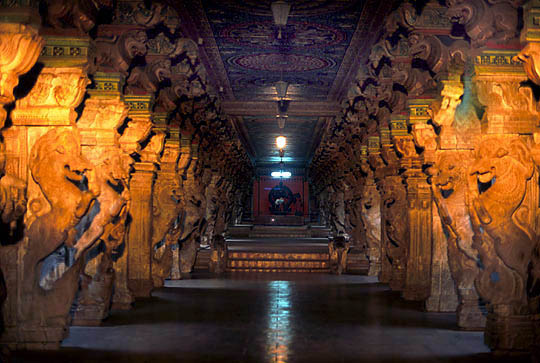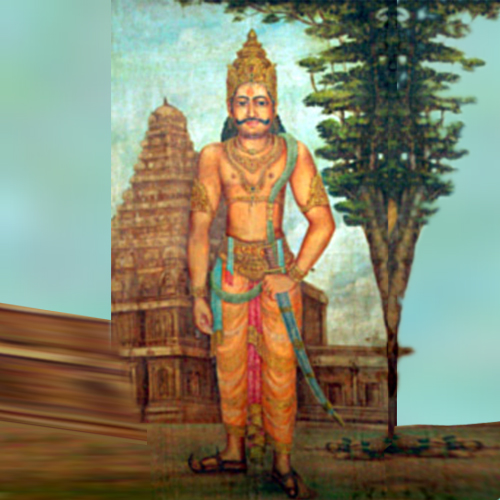
EMPEROR RAJARAJA CHOLA
Details of Rajaraja Chola’s services to Lord Shiva and how he served the cause of the Beloved Lord
History describes only few personalities as Emperors and boasts of their glories and achievements. One among them is Rajaraja Cholan of Chola Dynasty. Rajarajan was nick-named "Rajakesari", besides this name, he carries 42 different names. Having achieved the pinnacle of success, 1000 years ago, he carved a niche for himself in the pride of Cholas’ rule. His birthday is celebrated every year when his birthstar Chadayam falls during Iyppasi (Dhanur masam - Star: Shathabishak).
Rajarajan was born to Paranthakan II (who was later fondly called Ponmaligai Thunjiya Devar) and Vanavan Madevi, Kundavai Pirattiyar is his sister. Rajarajan had Loka Maadevi as his wife - besides 13 wives. He had also ruled with Raja Rajendran, his son, jointly from 1012 to 1014 (a.d.) Rajarajan possessed immense warfare techniques and his skills in combat were considered ’terror’ by enemies. He fought with Chera King, Bhaskara Ravivarman and defeated Chera’s navy in Kaanthaloor Road, he brought Pandyas under his control, defeated Sinhala King and attached Eelam (now Sri Lanka) under his flag. He also defeated and established his rule in Kudaku (Mysore) and Kalyani Chalukyas.
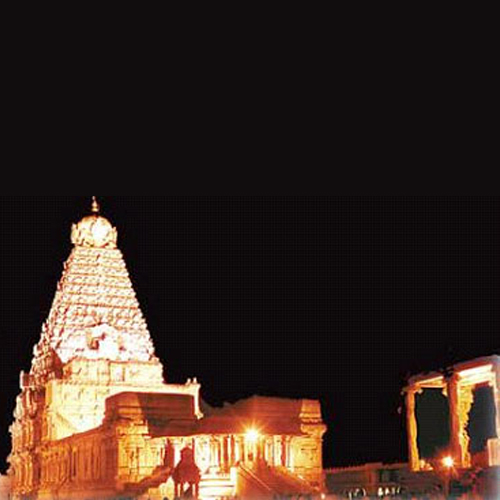 He resolved the family dispute of Venki Nadu Kingdom and gave his daughter Kunthavai in marriage to Vimalathiyan. During his reign as Chola King, his rule stretched upto the banks of Tunga Bhadra. A dedicated devotee of Lord Shiva, he extended all his assistance to Nambiyandar Nambi in unearthing and compiling Thirumarai (holy hymns) paadalkal, which was later called THEVARAM. He ordered Theveram to be sung in front of Lord Shiva in all Shaivite temples. He earned a name of "THEVARAM KANDA CHOZHAN" for restoring Tamil Veda of hymns. In order to announce the rich culture and advancement of architectural marvels of Tamils and their brilliant knowledge, he built a temple dedicated to Lord Shiva in Tanjore in 1010 (ad), called Rajarajeshwaram. He had shown keen interest in promoting art, music and culture. Everything flourished under his rule, be it culture, music or cultivation or dynasty.
He resolved the family dispute of Venki Nadu Kingdom and gave his daughter Kunthavai in marriage to Vimalathiyan. During his reign as Chola King, his rule stretched upto the banks of Tunga Bhadra. A dedicated devotee of Lord Shiva, he extended all his assistance to Nambiyandar Nambi in unearthing and compiling Thirumarai (holy hymns) paadalkal, which was later called THEVARAM. He ordered Theveram to be sung in front of Lord Shiva in all Shaivite temples. He earned a name of "THEVARAM KANDA CHOZHAN" for restoring Tamil Veda of hymns. In order to announce the rich culture and advancement of architectural marvels of Tamils and their brilliant knowledge, he built a temple dedicated to Lord Shiva in Tanjore in 1010 (ad), called Rajarajeshwaram. He had shown keen interest in promoting art, music and culture. Everything flourished under his rule, be it culture, music or cultivation or dynasty.
The temple he built was fondly called Big Temple and Nandi was made of one big stone. Most of the stones for the temple were brought from the Bank of Ganges. The presiding deity Goddess here is named Periya Nayaki Ambal. After seeing its architectural marvel, scientific calculations, UNESCO has declared it as a monument of treasure and advised all countries in the world, if there is an outbreak of war with India, not to attack this place thus creating a protective shield.
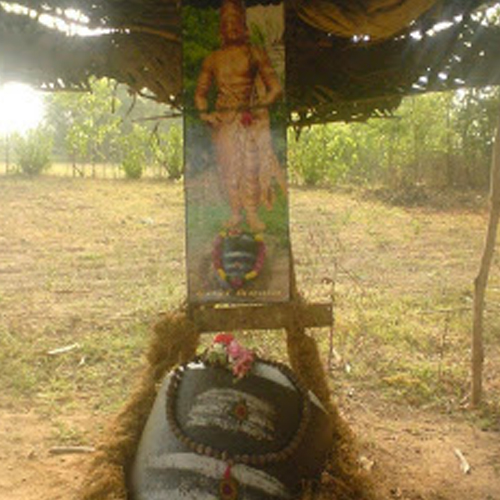 All pride goes to the entire magnanimous contribution of Rajarajan who was seen as a descendent of Lord Shiva's Amsam. He deserves our adoration and appreciation to celebrate his star during ayppasi. Let us join together in recalling his memorable dynastic rule and contribution to Hinduism in general and Shaivism in particular.
All pride goes to the entire magnanimous contribution of Rajarajan who was seen as a descendent of Lord Shiva's Amsam. He deserves our adoration and appreciation to celebrate his star during ayppasi. Let us join together in recalling his memorable dynastic rule and contribution to Hinduism in general and Shaivism in particular.
Lord Shiva is anointed with Sandalwood paste and milk on this day in Tanjore Big Temple.
We are proud to present this clipping to our devotees on this Pradosham day in memory of this great ruler.
Interesting Features
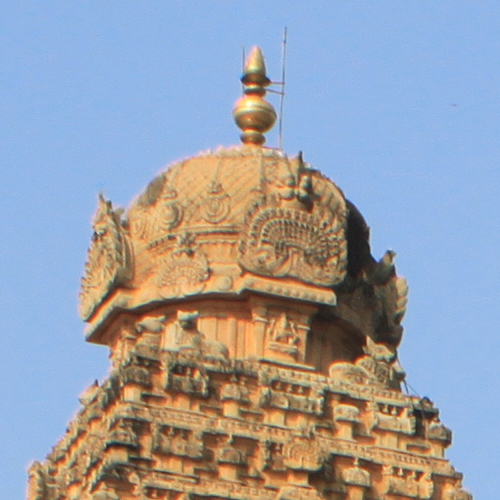 Temple Tower is capped by an 81.3 tonnes round monolithic cupola. This enormous piece of stone is said to have been was moved into position by moving it along an inclined plane 6 kms. long. The temple is considered an engineering skill of the Chola architects who planned its construction in such a way that the shadow do not fall on the earth.
Temple Tower is capped by an 81.3 tonnes round monolithic cupola. This enormous piece of stone is said to have been was moved into position by moving it along an inclined plane 6 kms. long. The temple is considered an engineering skill of the Chola architects who planned its construction in such a way that the shadow do not fall on the earth.
Matching the ’bigness’ of the temple is the gigantic Mahalingam in the shrine and the massive Nandi at the portals. Measuring 6m in length, 2.6m in breath and 3.7m in height, it is the second largest monolithic Nandi in India.
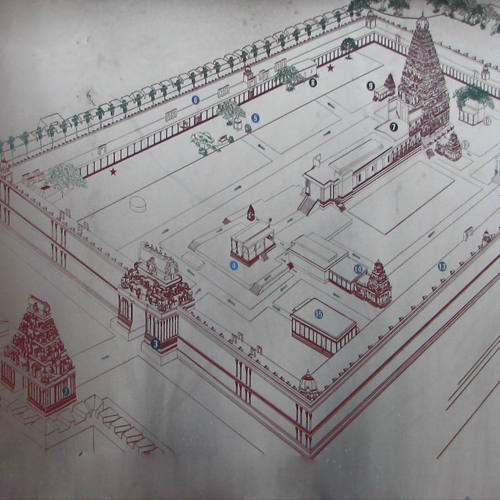 The great Vimana is of the Dravidian style of architecture. It rises to a height of abut 216 feet, a tower of fourteen storeys, finely decorated with pilasters, niches and images of gods of the Hindu pantheon. The basement of the structure which supports the tower is 96 feet square. The sikhara or cupolic dome is octagonal in shape and crowns the Vimana. The gilded Kalasa or finial, over it is 12.5 feet high. It is believed the sikhara and the stupi does not throw on the ground. The dome rests on a single block of granite, 25.5 feet square. Two Nandis, each measuring 6.5 feet by 5.5 feet beautify each corner of the stone which is estimated to weigh about 80 tons, and is believed to have been conveyed to the top of the tower by means of a inclined plane commencing from Sarapallam (scaffold-hollow), four miles north-east of the city.
The great Vimana is of the Dravidian style of architecture. It rises to a height of abut 216 feet, a tower of fourteen storeys, finely decorated with pilasters, niches and images of gods of the Hindu pantheon. The basement of the structure which supports the tower is 96 feet square. The sikhara or cupolic dome is octagonal in shape and crowns the Vimana. The gilded Kalasa or finial, over it is 12.5 feet high. It is believed the sikhara and the stupi does not throw on the ground. The dome rests on a single block of granite, 25.5 feet square. Two Nandis, each measuring 6.5 feet by 5.5 feet beautify each corner of the stone which is estimated to weigh about 80 tons, and is believed to have been conveyed to the top of the tower by means of a inclined plane commencing from Sarapallam (scaffold-hollow), four miles north-east of the city.

